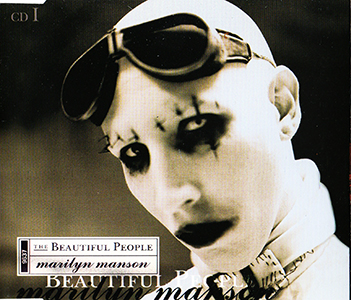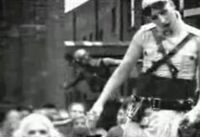The Beautiful People (song)
"The Beautiful People" is the first single of the second album Antichrist Superstar. Its lyrics discuss two major themes: what Manson refers to as "the culture of beauty", and that culture's connection to Friedrich Nietzsche's theory of master-slave morality — the song's "weak ones", who are "always wrong", are oppressed by and "justify [the existence of] the strong" (the so-called beautiful people). It remains known as one of Marilyn Manson's most famous and most successful original songs.
Contents
Appearances
Albums
Singles
- "The Beautiful People" Pt. 1 and 2
Versions
- The Beautiful People — Appears on Antichrist Superstar, Lest We Forget (The Best Of) and the "The Beautiful People" single.
- The Beautiful People (Edit) — Appears on the "The Beautiful People" promotional single.
- The Horrible People — Appears on the "The Beautiful People" Pt. 1 single, Remix & Repent and the Japan version of Lest We Forget (The Best Of).
- The Not So Beautiful People — Appears on the "The Beautiful People" Pt. 2 single and the Japan version of Lest We Forget (The Best Of).
- The Beautiful People (Full Metal Jacket Remix) — Used as the opening theme for WWE Raw from 1996 to 1998; otherwise unreleased.
- The Beautiful People (Live) — Appears on The Last Tour on Earth.
- The Beautiful People (Live) — Appears on the Guns, God and Government World Tour DVD.
- The Beautiful People (acoustic) — Recorded live with the Smashing Pumpkins on October 18th, 1997, at Bridge Benefit concert in Los Angeles
Background information
"The Beautiful People" was written in 1994; the lyrics are by Marilyn Manson and the music by Twiggy Ramirez. The original four-track demo version was recorded, in a hotel room while on tour, by Manson, Ramirez, and drummer Ginger Fish. Manson recalled to Kerrang! magazine in May 2005: "It was somewhere in the South, which is ironic. I remember playing the drum beat on the floor and then having my drummer duplicate that on the drum machine. It happened in one day pretty much".
The title of the song comes from Marylin Bender's 1967 book The Beautiful People, which exposed the world of scandal within the "jet-set" lifestyle of the 1960s, and the culture of beauty as it pertained to fashion and politics. The phrase itself was popularized by Vogue magazine in the early 1960s and was particularly used to describe the Kennedy family, a frequent source of inspiration in Marilyn Manson's work.
Themes
The track begins, after a few seconds of backwards-guitar feedback and electronic noise, with an extremely heavily-distorted spoken sample; it is Tex Watson declaring "[We would] swoop down on the town. . . [and] kill everyone that wasn't beautiful" (this sample was also used undistorted on the Spooky Kids track "Dune Buggy").
The song is written in drop D tuning, and is built primarily out of the notes of a diminished triad, each made into a power chord. It also incorporates extensive use of guitar distortion, and the use of palm muting creates a highly rhythmic, driving style which is amplified by a heavy percussion track. The song's characteristic element is its repetitive drum track, a five-beat common time pattern played on floor toms, in which swung notes create a jazzy, triplet feel.
Hard rock producer Sean Beavan, a musician with a close connection to jazz guitar, also appears on the track. Beavan, credited with "descending horn guitar", can be heard playing a repeated descending figure using a guitar effect which produces a brass instrument-like tone.
Lyrically, it is intertwined with the Antichrist Superstar album's overarching theme, a semi-narrative examination of the Nietzschean Übermensch. Within this context, "The Beautiful People" deals explicitly with the destructive manifestation of the Will to Power: "There's no time to discriminate", sings Manson, "hate every motherfucker that's in your way". A strong anti-capitalism sentiment stems from exploration of Nietzsche's view of master-slave morality ("It's not your fault that you're always wrong / The weak ones are there to justify the strong") along with its connection to Social Darwinism.
Music video
The music video, directed by Gloria Sigismondi, is what has been described as "the creepiest of creepy videos". The clip, filmed in the abandoned Goodenham and Worts distillery in Toronto, Canada, depicts the band performing the song in a classroom-like area decorated with medical prostheses and laboratory equipment. Intercut with these performance clips are scenes of lead singer Marilyn Manson in a long gown-like costume and aviator goggles, wearing stilts and prosthetic makeup which make him appear bald and grotesquely tall; after being placed in this costume by similarly-attired attendants, he appears to a cheering crowd through a window in a scene reminiscent of a fascist rally, and later stands in the center of a circle while people march around him giving the Hitler salute. Other fast cut scenes include extreme close-ups of crawling earthworms, mannequin heads and hands, and the boots of people marching; and shots of the individual band members bizarrely costumed, including Manson in back and neck braces and an apparent dental device which pulls the flesh of his mouth with hooks, exposing metallic teeth.
The video premiered on MTV on September 22, 1996 and was nominated for two 1997 Video Music Awards: Best Rock Video and Best Special Effects.
The video is available on the Lest We Forget (The Best Of) bonus DVD, as well as on the VHS compilation God Is in the TV.
Track listing
Australia
- "The Beautiful People" – 3:38
- "Cryptorchid" – 2:44
- "Snake Eyes and Sissies" – 4:07
UK, Pt. 1/Sweden
- "The Beautiful People" – 3:45
- "The Horrible People" – 5:43
- "Sweet Dreams (Are Made of This)" – 4:54
- "Cryptorchid" – 2:52
- "The Beautiful People" (Multimedia track featured on Enhanced CD)
- "Sweet Dreams (Are Made of This)" (Multimedia track featured on Enhanced CD)
UK, Pt. 2
- "The Beautiful People" (Album Version) – 3:38
- "The Not So Beautiful People" (Remix) – 6:12
- "Snakes Eyes And Sissies" – 4:07
- "Deformography" – 4:31
Japan
- "The Beautiful People" – 3:45
- "The Horrible People" – 5:43
- "Sweet Dreams (Are Made of This)" – 4:54
- "Cryptorchid" – 2:52
- "The Not So Beautiful People" (Remix) – 6:12
Picture Disc
- "The Horrible People" – 5:43
- "The Not So Beautiful People" (Remix) – 6:12
Promotional
- "The Beautiful People" (Clean Version) – 3:41
- "The Beautiful People" (LP Version) – 3:42
Lyrics
I don't want you and I don't need you
don't bother to resist, I'll beat you
It's not your fault that you're always wrong
the weak ones are there to justify the strong
the beautiful people, the beautiful people,
It's all relative to the size of your steeple
you can't see the forest for the trees,
and you can't smell
your own shit on your knees
hey you, what do you see?
something beautiful, something free?
hey you, are you trying to be mean?
if you live with apes, man, it's hard to be clean
there's no time to discriminate,
hate every motherfucker
that's in your way
the worms will live in every host
it's hard to pick which one they eat most
the horrible people, the horrible people
it's as anatomic as the size of your steeple
capitalism has made it this way,
old-fashioned fascism
will take it away
hey you, what do you see?
something beautiful, something free?
hey you, are you trying to be mean?
if you live with apes, man, it's hard to be clean
there's no time to discriminate,
hate every motherfucker
that's in your way
Trivia
- The single peaked at number 26 on the Modern Rock Tracks chart and remains known as one of Marilyn Manson's most famous and most successful original songs; in a 2004 review, Richard Banks of the BBC called the track "still the most impressive" in the band's catalogue, and it was ranked in 2006 at number 28 on VH1's 40 Greatest Metal Songs.

